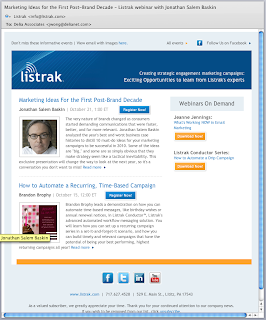1. The 'open rate' is not a reliable metrics to gauge reader engagement
First and foremost, you need to understand what 'open rate' really means. In Outlook or similar software, an open rate really means the user has scroll through his e-mails and yours were one of them. Roll through it again that's another open. even if he roll to your e-mail and than delete it in a second, that's an open. For users who wants to unsubscribe your e-mail, they have to 'open' it and click on the 'unsubscribe' button. So 'open rate' can be very deceiving. As a result, some e-mail distribution system also gives you a 'read rate'. A 'read' is registered when a user has your e-mail opened for more than a pre-defined time (usually 5-seconds or more). The theory is if the user has your e-mail opened for more than that pre-defined time, they are more than likely reading the actual content. However, this is only a small part to the story.
2. Make sure your readers know it is you before the images are downloaded
Most of you know this already, but it still needed to be said. Almost every e-mail clients block image from downloading automatically unless the user chooses to. That brings an interesting question to your e-mail design. Does you readers know the email they are looking at is from you without the images? Or is your content engaging enough that your readers will read without the images? To illustrate this point, take a look at this e-mail that came to my inbox this morning:
This is how your readers will see your e-mail. Every images displayed as if they are missing. For this e-mail sender, they use color schemes as an identifier to help their reader (like me) to identify who this is from.
Some of you might say: Hey, won't they know by the sender e-mail address? Just remember that most spammers uses forged e-mail headers to send you spam, so e-mail header cannot be the only identifier you use to gain your readers' trust.
Another way to identify yourself in HTML e-mails is to utilize ALT-tags for all images with WIDTH and HEIGHT definition. While this example doesn't show, ALT-tag will show in many e-mail clients in place of these images, giving readers another way to find out who this e-mail is from.
3. Give them multiple ways to engage with links and make the content sharable
 This is a somewhat new trend in e-mail marketing. Make sure you connect your e-mail campaign with your social media content to further gain your readers' trust as well as making your content more accessible. This means placing a facebook icon, twitter icon, and any other social media destination of which you have exposure on, and let the sharing begin.
This is a somewhat new trend in e-mail marketing. Make sure you connect your e-mail campaign with your social media content to further gain your readers' trust as well as making your content more accessible. This means placing a facebook icon, twitter icon, and any other social media destination of which you have exposure on, and let the sharing begin.While this approach also requires you to deploy an online copy of your e-mail on these social media (or on your own web) channels, it gives your readers another way to engage with your content and share it with their friends and colleagues.
As this example from listrak shows, the social media icons located at the bottom allows readers to share this e-mail content with everyone in their network who might not be a customer of listrak or a subscriber of this e-mail. This gives your subscribers a chance to spread the word for you if they found your content to be engaging.
4. CONTENT IS KING!
So far I've only been talking about how you can engage with technologies and how to understand the analytic. At the end of the day, your e-mail campaign is only as good as your content. Even if you do everything right, you won't get your readers to engage if your content is less than interesting. Try to avoid launching an e-mail campaign filled with PR, but develop content that are relevant and beneficial to your readers, and this will only come if you know your readers. Stop buying e-mail list simply because you don't know who they are and what interest them, but rather spend the time to build an opt-in list with people that you know, or at least know what may interest them. I'll talk about how to build an opt-in list tomorrow.
In the mean time, feel free to comment and add whatever you feel is also important in the comment area.

No comments:
Post a Comment